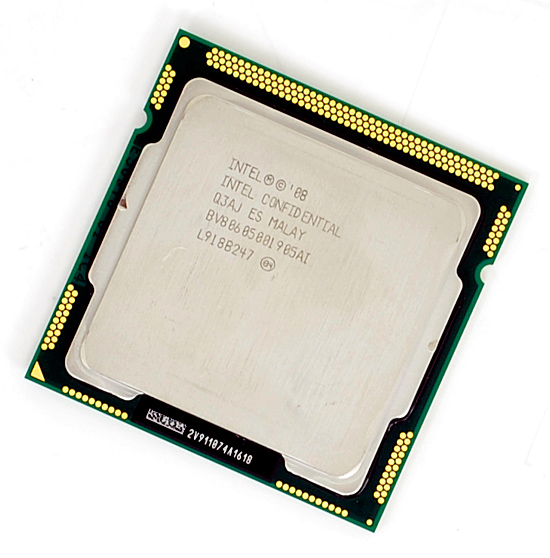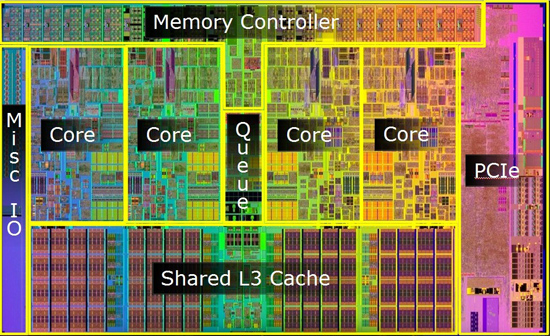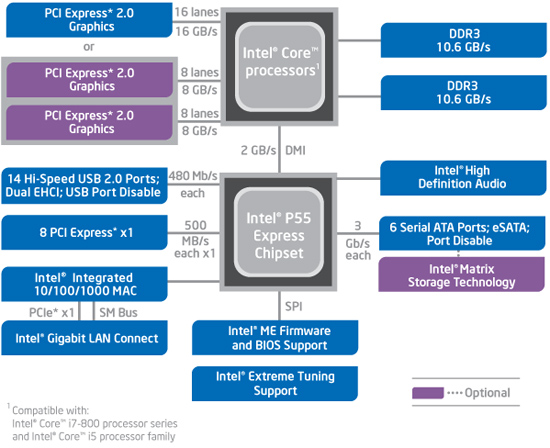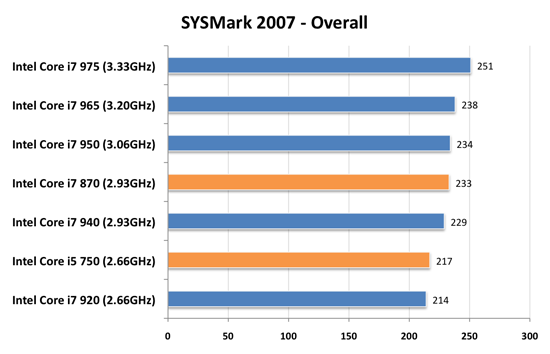Intel's Core i7 870 & i5 750, Lynnfield: Harder, Better, Faster Stronger
by Anand Lal Shimpi on September 8, 2009 12:00 AM EST- Posted in
- CPUs
Intel is on the verge of transitioning to 32nm. We'll see the first parts this year. What do you do with your 45nm fabs when you start moving volume away from them? Make really cheap quad-core Nehalems of course:

I'm talking $196. I'm talking faster than AMD's entire lineup. I'm talking about arguably the best processor of 2009. I'm talking about Lynnfield, and here's its backside:

Mmm
I spent much of the past year harping on AMD selling Nehalem-sized Phenom IIs for less than Intel sold Nehalems. With Lynnfield, Intel actually made Nehalem even bigger all while driving prices down. Like I said, what do you do when you're still making boatloads of money in a recession and are about to start emptying your 45nm fabs?
I should clear things up before we progress much further. Lynnfield is the codename for mainstream 45nm quad-core Nehalem, while Bloomfield refers to the first Nehalem launched at the end of 2008:
| Processor | Manufacturing Process | Die Size | Transistor Count | Socket |
| Bloomfield | 45nm | 263 mm2 | 731M | LGA-1366 |
| Lynnfield | 45nm | 296 mm2 | 774M | LGA-1156 |
Despite being cheaper, Lynnfield is larger than Bloomfield. The larger die is due to one major addition: an on-die PCIe controller.

Bloomfield, The First Nehalem, circa 2008

Lynnfield, Nehalem for All, circa 2009
The pink block to the right of the die is the PCIe controller, that's 16 PCIe 2.0 lanes coming right off the chip. Say hello to ultra low latency GPU communication. You'd think that Intel was about to enter the graphics market or something with a design like this.
Sacrifices were made to reduce CPU, socket and board complexity. Gone are the two QPI links that each provided 25.6GB/s of bandwidth to other CPUs or chips on the motherboard. We also lose one of the three 64-bit DDR3 memory channels, Lynnfield only has two like a normal processor (silly overachieving Bloomfield).

Intel's Bloomfield Platform (X58 + LGA-1366)
The sum is that Lynnfield is exclusively single-socket; there will be no LGA-1156 Skulltrail. While the dual-channel memory controller isn't really a limitation for quad-core parts, six and eight core designs may be better suited for LGA-1366.

Intel's Lynnfield Platform (P55 + LGA-1156)
The loss of QPI means that Lynnfield doesn't have a super fast connection to the rest of the system, but with an on-die PCIe controller it doesn't matter: the GPU is fed right off the CPU.
The Lineup
We get three Lynnfield CPUs today: the Core i7 870, Core i7 860 and the Core i5 750. Intel's branding folks told us that the naming would make sense one we saw the rest of the "Core" parts introduced; yeah that was pretty much a lie. At least there aren't any overlapping part numbers (e.g. Core i5 860 and Core i7 860).
The i7 in this case denotes four cores + Hyper Threading, the i5 means four cores but no Hyper Threading. The rules get more complicated as you bring notebooks into the fray but let's momentarily bask in marginal simplicity.
| Processor | Clock Speed | Cores / Threads | Maximum Single Core Turbo Frequency | TDP | Price |
| Intel Core i7-975 Extreme | 3.33GHz | 4 / 8 | 3.60GHz | 130W | $999 |
| Intel Core i7 965 Extreme | 3.20GHz | 4 / 8 | 3.46GHz | 130W | $999 |
| Intel Core i7 940 | 2.93GHz | 4 / 8 | 3.20GHz | 130W | $562 |
| Intel Core i7 920 | 2.66GHz | 4 / 8 | 2.93GHz | 130W | $284 |
| Intel Core i7 870 | 2.93GHz | 4 / 8 | 3.60GHz | 95W | $562 |
| Intel Core i7 860 | 2.80GHz | 4 / 8 | 3.46GHz | 95W | $284 |
| Intel Core i5 750 | 2.66GHz | 4 / 4 | 3.20GHz | 95W | $196 |
Keeping Hyper Threading off of the Core i5 is purely done to limit performance. There aren't any yield reasons why HT couldn't be enabled.
Intel was very careful with both pricing and performance of its Lynnfield processors. I'm going to go ahead and say it right now, there's no need for any LGA-1366 processors slower than a Core i7 965:

This is only one benchmark, but it's representative of what you're about to see. The Core i7 870 (LGA-1156) is as fast, if not faster, than every single LGA-1366 processor except for the ones that cost $999. Its pricing is competitive as well:

For $196 you're getting a processor that's faster than the Core i7 920. I'm not taking into account motherboard prices either, which are anywhere from $50 - $100 cheaper for LGA-1156 boards. I don't believe LGA-1366 is dead, but there's absolutely no reason to buy anything slower than a 965 if you're going that route.










343 Comments
View All Comments
Scheme - Tuesday, September 8, 2009 - link
Why is it assumed enthusiasts or technical users are only interested in overclocking? For me it's about balancing performance, temps, noise levels and power consumption, all with a reasonable cost of entry. All that considered Lynnfield seems to be a good platform.Ann3x - Tuesday, September 8, 2009 - link
Well the d0 can usually hit 3.8-4ghz on std voltages.So tbh temps dont really come into it. Anyone with a 920 should overclock it because there is really nothing to lose. No need to risk the cpu, negligible temperature increases, its all positive.
If you buy a 920 and dont overclock you either should have a very good reason or you dont know how to.
The 920 is a very meh processor at stock. The reason its so popular is its potential to overclock so easily and so highly not its stock speeds.
Scheme - Tuesday, September 8, 2009 - link
3.8-4ghz will involve more than what I'd consider to be 'negligible temperature increases'.Ann3x - Tuesday, September 8, 2009 - link
I can hit 4Ghz on air with stock voltage with a max load (10hrs of LinX) of 65C. Thats so far within the thermal limits of the CPU to be considered totally negligible. My results seem very typical for d0 920s.Enthusiast CPUs need to be treated (and reviewed) in context with their market. If some people are too stupid to see the potential of their mid range CPUs then Id at least expect a good site like anandtech to realise it and not act like stock is the only option.
There is a reason why 90% of X58 motherboards are marketed on their overclock and performance options.
erple2 - Tuesday, September 8, 2009 - link
I'm a bit more interested in relatively low power consumption, and stable (as in for 4 years) operation, not how many fractional increases in performance I can eke out of a CPU at potentially catastrophic failure rates through overclocking. However, I'm buying a CPU for it's solid performance, reliability (the i7's haven't been out long enough to make any judgement of it's long term reliability), and lower power consumption. Also, can you still claim RMA status on a broken CPU that was potentially damaged by overclocking? I haven't read any Intel literature to suggest that you can.I don't care at all about what you think I my goals with buying a CPU for are. Your class of "enthusiast" is really "the overclocking user", not the "enthusiast".
I suppose it would be more interesting to find out how many of the X58 purchasers actually overclock their CPUs (beyond what "turbo" buys you), and then make conclusions, rather than this handwaving "you're an idiot if you do something other than what I do" mentality that you are showing.
I'd also like to see how many of those "90% of X58 mobos marketed on their overclock and performance options" (reference please!) are actually sold vs. those that are cheaper, and not marketed on overclocking performance. Maybe that "other 10%" sells about 40-50% of the market. Do you have data to suggest otherwise?
Ann3x - Wednesday, September 9, 2009 - link
You really think you can damage a cpu by just increasing the clock? Wow.Only things that damage CPUs are overvolting (not needed for a decent OC on the i7) and high temps (usually linked directly to overvolting). The concept that an overclock at stock voltage could cause "catastrophic failure" is frankly laughable.
A sensible overclock will be no more or less stable than stock. The only people who actually risk system stability are the ones who overvolt and push the limits. For the record 3.8-4ghz is most definitely NOT pushing the limits.
Again ill say it. If youre buying an X58 motherboard you are PAYING for the ability to overclock. If you choose not to there is little - no point in the platform (with the possible exception of people who use very multi threaded apps). The proof in this point is actually staring you in the face in the i5/new i7, their design shows that intel realises the headroom they have in the architecture. The aggressive turbo mode of the i5/new i7 is proof that there is NO risk in overclocking within sensible limits at stock voltage.
In reality the main "huge leap forward" of the new platform is simply the acceptance of overclocking within intel.
That you choose to ignore the potential of your CPU is your own loss. Intel think its safe to overclock but hey, you know better right :). Im just surprised that anand chooses to for the most part ignore this and makes absurb attention grabbing statements instead of assessing the real merits of the 2 platforms. It really is a rose tinted glasses review but oh well. Keep your heads stuck in the sand.
yacoub - Tuesday, September 8, 2009 - link
Great article except it would have been REALLY nice to have the i7 860 data, given that's most likely the best bang-for-the-buck Lynnfield option and it probably makes MUCH more sense price-wise than going for the 870. It REALLY sucks not knowing where that chip slots in for all the tests you did.This is exactly the concern I listed when the polls were posted that asked which CPU we most wanted to see benchmarked. Clearly we want to see ALL THREE.
That said, it's nice to see Lynnfield is basically awesome, except in Crossfire/SLI which is about the LAST thing I could give a crap about. So really, this looks about perfect. (Only on page 14 though, but if it continues as it has to this point, I'm sold.) I just wish the 860 had been benchmarked.
Gary Key - Tuesday, September 8, 2009 - link
I have the 860 in the upcoming mb roundups. :)yacoub - Tuesday, September 8, 2009 - link
I knew there was a reason we all love us some Gary Key. \m/. :)529th - Tuesday, September 8, 2009 - link
I'm not sure what bios setting is Sleep State on the i7 9xx (1366) but for discussions sake, say C1E sleep state is disabled, as overclockers usually do this, does that negate the logical functioning of Turbo mode and run all cores at the max TDP & speed? So would a 1366 system be faster with turbo & C1E sleep state disabled? ...i'm not even sure if i'm asking that right.. i'm still reading up on the PCU and Turbo section